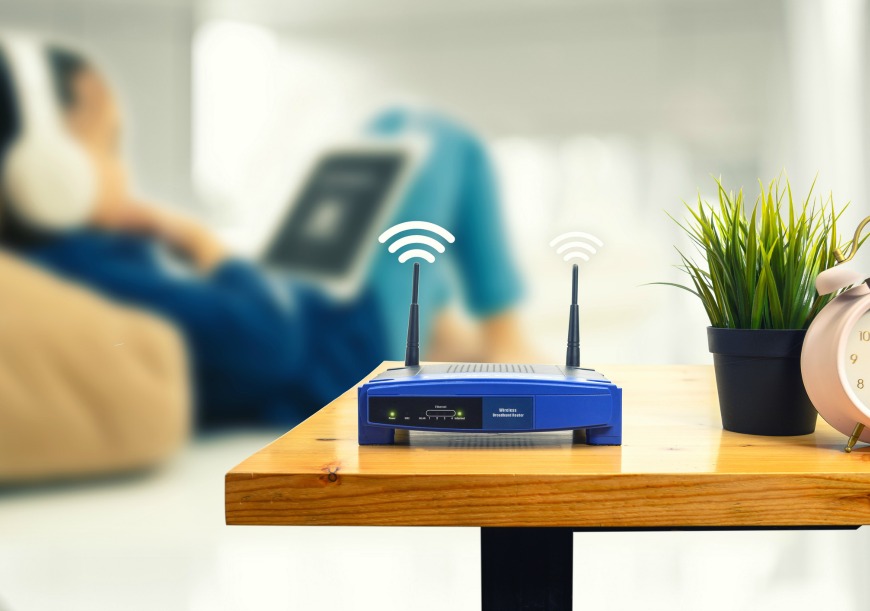
Nov 15, 2019 | WI FI
When it comes to the dependability and speed of the internet service in your home, a lot depends on your WiFi router―specifically its location in the house.
At PRTC, we’ve already got you covered with the area’s fastest and most reliable internet service. Now here are a few tips on getting the most from that service throughout your home.
Make Sure You Have Enough Coverage: If your home is less than 1,500 square feet, one router should provide enough coverage for your whole house. However, if your house is larger, you may want to look into creating a mesh network. A mesh network is a series of access points that communicate with each other to blanket your home with the WiFi signal. They optimize the speed of your connection and reduce “dead zones.”
Consider Where You Spend the Most Time Connected: If you have key locations in your home where you spend the majority of your time online, such as a home office or family room, take that into consideration when placing your router.
Look for a High and Uncrowded Space: Placing your router on a high shelf will help distribute the signal more widely and evenly through the house. It’s also best to avoid placing the router behind any large objects or closed up in a cabinet.
Give the Signal a Clear Path: While the WiFi signal can do a pretty good job getting through the walls and ceilings in your house, the one thing that can stop it cold is metal, including shelving, metal desks, and large appliances.
For more information about router placement, or to order the fastest Internet in town, call 843-538-2020.

Nov 15, 2019 | Uncategorized
Not all internet options are created equal. All it takes is one missed virtual meeting or one lagging video game to realize that your current internet speeds may not be sufficient. If you aren’t happy with your current speeds, you may want to look into other options. But which service is best for you? Let’s explore the speed, reliability, and bandwidth of the three major service delivery options—landline telephone line (DSL), cable TV line (cable), and fiber-optic line (fiber)—to understand why fiber is the clear choice for today’s citizens of the internet.
Internet Speed
Fiber-optic broadband, which uses glass, offers faster internet speeds over greater distances than its copper-based competitors such as DSL and cable. “Fiber to the Home” (FTTH) internet service providers (ISP) boast gigabit-level speeds up into the 100–1,000 Mbps range—several times faster than the maximum offered by its counterparts. Comparatively,DSL speeds max out at about 45 Mbps, while cable hits top speed at 300 Mbps. While that may sound like more than you’ll ever need, the capacity and speed of cable and DSL fluctuate during times of demand, which can leave you lagging when you have a pressing deadline or virtual meeting to attend.
Internet Reliability
Simply put, if reliability is important to you, choose fiber. DSL and cable experience significant slowdowns during peak hours and during extreme weather conditions such as drastic temperature changes and flooding. Fiber alone withstands all of these conditions, including the heave usage of peak hours. Keep in mind that unplanned downtime adds a serious cost to both your productivity and bottom line.
Internet Usage
Don’t make the mistake of underestimating your internet usage. The reality of technology advancements is that most of us are now high-capacity users. How many desktops, laptops, tablets, phones, and gaming systems are competing for bandwidth in your home? Do you stream Netflix or Hulu or videos on YouTube? Do you play video games or games on your phone? Do you have a security system or a video doorbell monitor that requires internet connection to function? What about a home assistant device? Even smart appliances like washers, dryers, and refrigerators usually need an internet connection. As we get more connected, a lightning-fast internet connection becomes increasingly important.
Ready to make the switch to fiber? Contact PRTC at 843-538-2020 today!

Nov 15, 2019 | Uncategorized
The future of the internet is sharing―from capturing Instagram-worthy meals to enjoying video chats with friends―and PRTC’s unmatched upload speeds make that future a reality.
Here are a just few ways PRTC’s fast, reliable upload speeds make your life easier:
Video chat and live sharing
Skype, FaceTime, and other video messaging services all require robust upstream connections to ensure clear audiovisual quality and to prevent freezing and blackouts. Sharing big news on Facebook or Instagram Live also works better with greater upload speed.
Working or going to school from home
You need a robust upstream connection to interact with colleagues during video conferences, collaborate on team projects, and share important files. Online studies also can tax your upstream connection, especially if you join a virtual classroom or share large portfolios.
Keeping family, friends, and followers in the loop
Upload new videos to YouTube or share photographs with Flickr faster with a better upstream connection.
Faster data backups and online file synching
If you back up your data with a service like Backblaze or Carbonite, you need upload speed that meets basic requirements to ensure your data is protected quickly and without glitches. File and photo synching services like Dropbox, Google Photos, and Microsoft OneDrive all require a minimum of 5 Mbps upload speed to operate properly, and the more upload capacity available, the faster these services can sync and share files.
Online gaming, remote security and much more…
From online gaming to connected security systems that send real-time images through an internet connection, a fast upload connection is key to ensuring all your interactive online activities function well.

Nov 15, 2019 | Uncategorized
Testing the speed of your internet connection is easy, but it’s also easy to misunderstand the results. Your devices — TVs, routers, smartphones, laptops, desktops, etc. — have different capabilities, and you can get different results on each one, even while using the same internet connection.
This is particularly noticeable to users taking advantage of higher speed packages offered by PRTC.
Here are a few things to keep in mind when evaluating your speed test results:
HARD-WIRED VS. WIRELESS
That old-school cord-and-plug is simply more reliable than WiFi (wireless) connectivity. Even those super-fast 1 Gbps connections, now widely available across the country, won’t test out at higher than 500 to 700 Mbps when tested over WiFi. For the most accurate speed test result you must test with a hard-wired device.
Why? Because there are nearly endless variables that can negatively affect a WiFi signal, everything from nearby construction or the wireless printer in the home office to a baby monitor or microwave in use in the home.
Keep in mind that one limitation with a hard-wired connection is testing with a device that has a 100 Mbps NIC (Network Interface Card). This can cause you to consistently receive speed test results at 90-98 Mbps. PRTC recommends testing on a device that has a 1 Gbps NIC.
POSSIBLE PROBLEMS AFFECTING SPEED AND SPEED TESTS
Slow internet speeds are sometimes caused by malware such as adware and viruses. There are several free and inexpensive programs and apps to deal with that, and they’re important to use for many reasons.
This also sounds obvious, but it’s very easy to overlook any ongoing downloads or programs like video chat that may be turned on while you’re conducting a speed test on your device. Close these applications, reboot your device, and test again.
Even the browser you use — Chrome, Firefox, Safari, Microsoft’s new Edge, etc. — can affect your test speed. Try different browsers to see if that’s the case on your system.
If you have a WiFi extender, make sure you turn it off before you run a speed test. Otherwise, your computer may test the wrong connection.
This brings us to a final point about equipment. Technology advances constantly, and many older routers and computers simply cannot take full advantage of the blazing speed and bandwidth of today’s fiber broadband connectivity.
When you’re ready to upgrade your technology, make sure your new equipment has the network cards and internal processing power that can leverage the speed of market-leading fiber broadband like that from PRTC.




